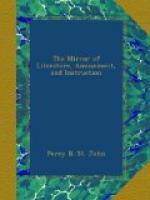The ancient buildings of the Rugby seminary were a humble tenement for the schoolmaster, a principal school-room, and two or three additional school-rooms, built at different times, as the finances would allow. These being found too limited, in 1808 the trustees commenced the erection of the present structure, from the designs of Mr. Henry Hakewill. It stands nearly on the same spot as the former humble building, and is composed of white brick, the angles, cornices, and dressings to the windows and openings being of Aldborough stone. The style of architecture is that of the reign of Elizabeth, the period at which the school was founded. The building is massy, august, and interesting from its graceful disposition of parts. The principal front is that represented in our engraving, which extends 220 feet.
The schools are entered by a gateway opposite the street, which leads to the principal court, a fine area, 90 feet long by 75 feet wide, with a plain cloister on the east, south, and west sides. The buildings on the south of the court comprise the dining hall, belonging to the boys in the head master’s house, and three schools for different classes; those on the west are occupied by the great school; and on the north are the French and writing schools. The east side adjoins the offices belonging to the head master’s house. About sixty boys are accommodated here; the remainder lodge in the houses of the other masters, and in the town of Rugby.
Lawrence Sheriff, the benevolent founder of this institution, was born at Brownsover, whence he removed to London, where he kept a grocer’s shop in Newgate-street. A more gratifying portrait of true beneficence than Sheriff’s bequest can scarcely be found in British annals; and this gratification is greatly enhanced by the justice with which his intentions have been carried into effect at Rugby. The alms-houses were originally for four poor old men; but the dwellings have been augmented in proportion to the increased revenues.
[1] Their annual meeting is
in August, when the examination takes
place.
Fourteen exhibitions have been instituted, each of
the
exhibitioners
being allowed forty pounds per annum to assist in
their
support, for seven years, at either university.
* * * * *
CHOICE HINTS FOR A PLAN TO DISCHARGE THE NATIONAL DEBT.
(For the Mirror.)
“Great events sometimes spring from trivial causes,” of the truth of this adage, no man is, I think, so great a heretic, as to express any doubt—were such the case, it would be by no means difficult to conjure up a host of evidence, in support of our proposition; but, seeing that “such things are,” let us at once to the point.
The present age is so rife in whims and proposals, that I am rather apprehensive, some may doubt the feasibility of the following. Nevertheless, it is, methinks, quite as good, as many others which recently were strangled, in struggling for existence.




